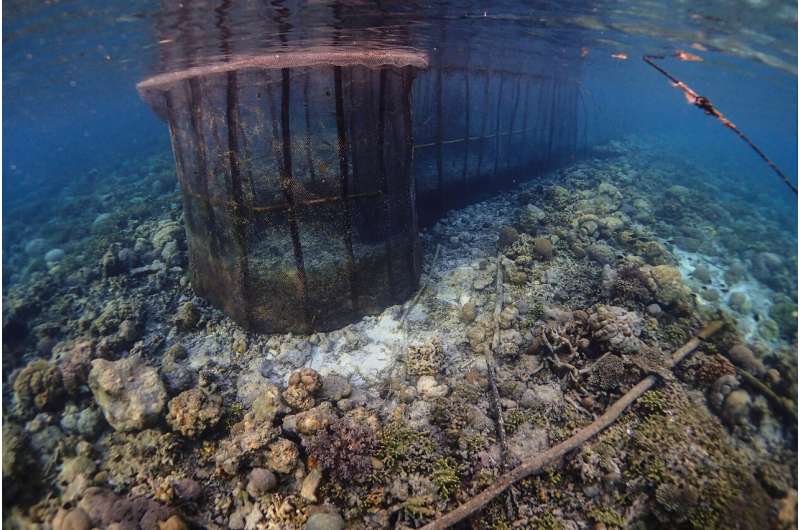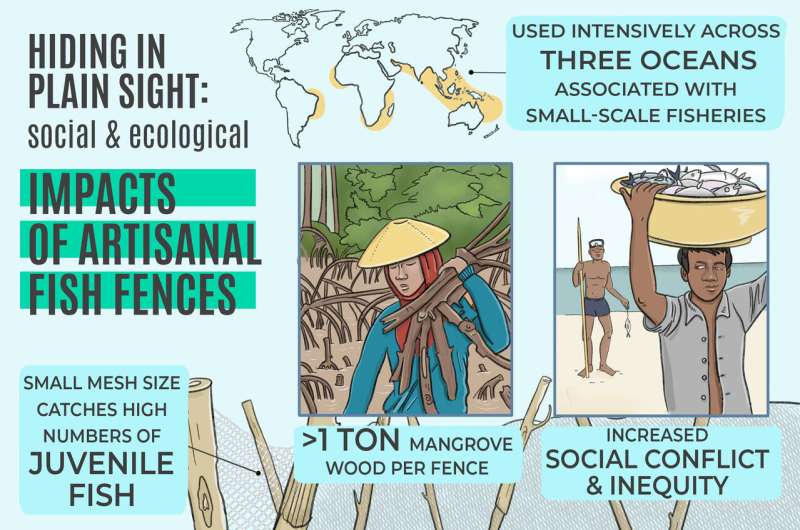Fish fences across the tropical seas having large-scale devastating effects

Huge fish fences which are commonly used in tropical seas are causing extensive social, ecological and economic damage and are threatening marine biodiversity and human livelihoods, according to a new study.
Fish fences are a common type of traditional fishing gear regularly constructed from mangrove poles and nets spanning hundreds of metres which are placed semi-permanently in shallow habitats.
Using ecological, social and remote sensing methods, the research team examined the landings from fish fences over a 15-year period and assessed the health of condition of local seagrass, mangroves and reef habitats.
Dr. Richard Unsworth from Swansea University, co-author of the study, explained: "These fences which are common across the Pacific, Atlantic and Indian oceans are so large they can be seen from space using Google Earth. Because they are unselective, they catch more than 500 species, many as babies or which are of conservation concern. It's not surprising that these fisheries are having a disastrous impact on tropical marine ecosystems such as seagrass meadows, mangroves and coral reefs.
"Over a 10-year period local reef fish density was found to decline by half as a result of these fisheries. Fisheries management often targets commercial and industrial fishing gears, and allows for the use of more traditional fishing gears that are often referred to as 'sustainable'. This work challenges that assumption."

Dr. Gabby Ahmadia of the World Wildlife Fund and co-author on the study, said: "This study demonstrates the widespread impact of fish fences, which are often used in some of the world's poorest countries where reliance on marine resources is high. Our research reveals that some of these traditional fishing fences have a much higher impact than we initially thought, and we need to work with communities and local governments to identify solutions that can support traditional practice, but also promote sustainable fisheries and provide equitable benefits for people."
Dr. Dan Exton of Operation Wallacea and lead researcher of the study, said: "Fisheries management is not just about how many fish are being caught, it's about how those fish are being removed, and understanding the far-reaching impacts of a single fishing technique. Governments, National Government Organisations and communities need to direct management efforts toward fishing techniques that are having the most harmful impacts. This could help with sustainability, and even increase short-term resilience to climate change."
The research team that published the research is made up of researchers from Operation Wallacea, Essex and Cardiff Universities, World Wildlife Fund, Cornell University (USA), and Hasanuddin University (Indonesia).
The paper, entitled 'Artisanal fish fences pose broad and unexpected threats to the tropical coastal seascape', is published in Nature Communications.
More information: Dan A. Exton et al. Artisanal fish fences pose broad and unexpected threats to the tropical coastal seascape, Nature Communications (2019). DOI: 10.1038/s41467-019-10051-0
Journal information: Nature Communications
Provided by Swansea University





















